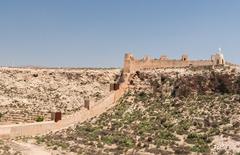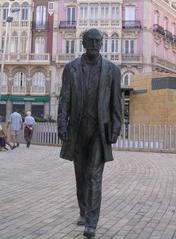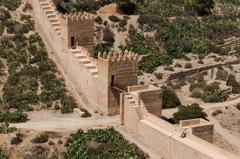Visiting the Observatorio Geofísico de Almería: Hours, Tickets, and Travel Tips
Date: 14/06/2025
Introduction
The Observatorio Geofísico de Almería is a landmark of Spain’s scientific heritage, reflecting over a century of geophysical research and innovation. Founded in the early 20th century in the Los Ángeles district of Almería, the observatory has played a pivotal role in seismic, meteorological, and geomagnetic studies. Today, it stands as both a historical testament and a promising future sociocultural center. This guide provides comprehensive, up-to-date information for prospective visitors, detailing its history, current status, visiting logistics, and the rich array of nearby attractions in Almería.
What to Expect: The Legacy and Experience
Historical Significance
Established in 1910 and operational from 1912, the Observatorio Geofísico de Almería was initially focused on seismology and meteorology. Its scope broadened in 1955 to include geomagnetism, making it a cornerstone in Spain’s early earthquake risk assessment and atmospheric monitoring systems. The observatory contributed vital data for Spain’s first magnetic map and became part of the national geomagnetic network, alongside other observatories in Logroño, Moca, and Tenerife (IGN’s geophysical archives).
Architecturally, the site features unique pavilions connected by covered galleries, designed to minimize magnetic interference. A distinctive hydraulic system with cisterns and a large reservoir underscores its technical and heritage value.
Evolution and Current Status
Due to urban expansion and resulting electromagnetic interference, the observatory ceased scientific operations in 1989. While its research functions have moved to modern facilities, the building remains an emblem of scientific and cultural heritage. The Almería City Council and local community groups are actively working to repurpose it as a sociocultural center with future plans for exhibitions, workshops, and public events (La Palmera).
Visiting the Observatorio Geofísico de Almería
Hours and Ticketing
Current Status:
- The observatory is not open for regular public visits as of June 2025.
- No ticketing system is in place; entry is only possible during special events or guided tours, which are announced occasionally by the city council or local associations.
How to Stay Updated:
- Check the Almería City Council website and Instituto Geográfico Nacional for the latest updates on public access, events, and visitor opportunities.
Location and Accessibility
- Address: Situated in the Los Ángeles district, Almería, Spain.
- Getting There: Easily accessible by car and public transport from the city center.
- Accessibility: Some features accommodate visitors with limited mobility, but as the site is in transition, it’s best to confirm accessibility details before planning a visit.
- Photography: The observatory’s exterior can be viewed and photographed from public streets.
Guided Tours and Educational Programs
- Guided Tours: Offered only during special open days or community-organized events, with a focus on the observatory’s scientific legacy and architectural features.
- Educational Activities: Previously, the site hosted a small seismic museum and educational programs for schools. These may be revived as part of future sociocultural use.
Travel Tips and Nearby Attractions
- Best Time to Visit: Monitor local announcements for special opening events, typically scheduled in spring or autumn.
- Nearby Attractions:
- Alcazaba Fortress: A significant Moorish monument with panoramic views.
- Almería Cathedral: Known for its fortress-like structure.
- Museo de Almería: Archaeological and historical exhibits.
- Cable Inglés: Historic iron pier.
- Cabo de Gata-Níjar Natural Park: For nature enthusiasts.
- Local Cuisine: Sample traditional Andalusian dishes in nearby restaurants after your visit.
Scientific and Cultural Legacy
Although inactive as a research center, the observatory’s seismic and geomagnetic data—archived by the Instituto Geográfico Nacional—continue to inform scientific studies and preserve the region’s geoscientific history (IGN Archive). The preservation and future repurposing of the observatory reflect Almería’s commitment to valuing both its scientific and cultural heritage.
Frequently Asked Questions (FAQ)
Q: Can I visit the Observatorio Geofísico de Almería now?
A: The observatory is currently closed for regular visits. Limited access is occasionally available during special events.
Q: Are tickets required?
A: No, as the site is not open for regular tourism. Entry is by arrangement during special events only.
Q: Are guided tours available?
A: Occasionally, as part of community or city council initiatives. Check local tourism resources for announcements.
Q: Is the site accessible by public transport?
A: Yes, it is easily reachable by bus or on foot from Almería city center.
Q: What other sites should I visit nearby?
A: The Alcazaba, Almería Cathedral, Museo de Almería, and the Cable Inglés pier.
Q: Where can I find updates?
A: Follow updates from the Almería City Council and IGN.
Visual Gallery
While on-site photography is limited, high-quality images of the observatory’s historic buildings and grounds can be found on municipal and IGN websites. Visitors are encouraged to explore virtual galleries and official resources for detailed visuals.
Practical Visitor Recommendations
- Check official sources regularly for updates on opening status and upcoming events.
- Plan your itinerary to include other cultural landmarks in Almería for a fuller experience.
- Download the Audiala app for real-time updates, cultural guides, and scientific content related to the observatory and Almería.
Summary
The Observatorio Geofísico de Almería stands as a monument to Spanish scientific achievement and a symbol of Almería’s evolving cultural landscape. While it no longer functions as an observatory, its planned transformation into a community and cultural hub ensures its legacy will endure. Visitors should monitor official announcements for opportunities to experience its storied history firsthand, and complement their trip with visits to Almería’s rich array of historical and natural sites. For up-to-date information, rely on trusted resources like the Instituto Geográfico Nacional, La Palmera, and local tourism offices.
Sources
- La Palmera – Observatorio Geofísico de Almería
- Instituto Geográfico Nacional Geophysical Network
- IGN Official Visitor Page
- Turismo de Almería



